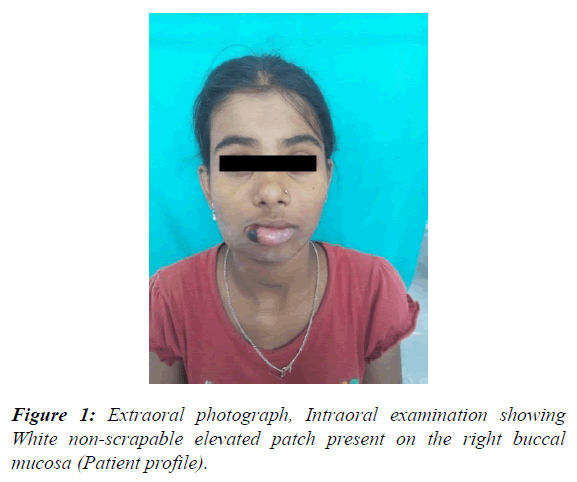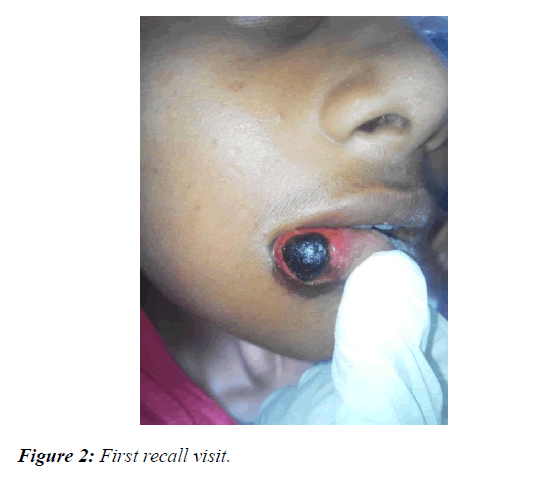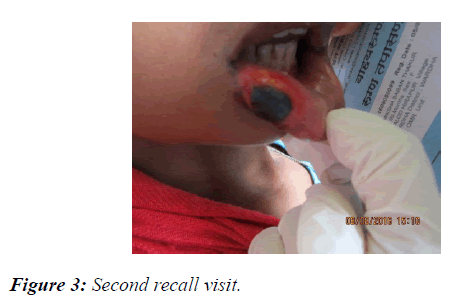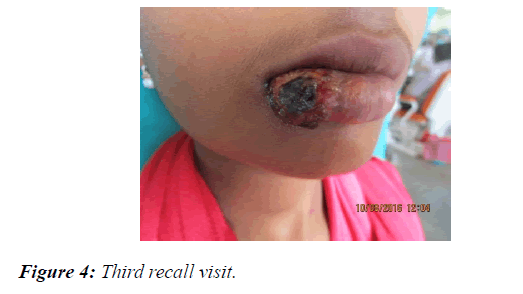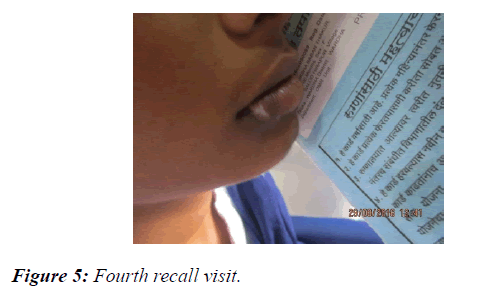Case Report - Journal of Clinical Dentistry and Oral Health (2017) Oral Medicine and Surgery
Lip abscess due to insect bite- A case report
Supriya Vijay Gupta1*, Vidya Krishnarao Lohe1, Rahul Raghunath Bhowate1, Tulika Narendra Soni2 and Ankur Banode3
1Department of Oral Medicine and Radiology, Datta Meghe Institute of Medical Sciences, Wardha, Maharashtra, India
2Department of Periodontics, Datta Meghe Institute of Medical Sciences, Wardha, Maharashtra, India
3Department of Conservative Dentistry and Endodontics, Swargiya Dadasaheb Kalmegh Smruti Dental College and Hospital, Nagpur, Maharashtra, India
- *Corresponding Author:
- Supriya Vijay Gupta
Datta Meghe Institute of Medical Sciences
Wardha, Maharashtra, India
E-mail: supriya.gupta130@gmail.com
Accepted on November 21, 2017
Citation: Gupta SV, Lohe VK, Bhowate RR, et al.. Lip abscess due to insect bite- A case report. J Oral Med Surg 2017;1(1):27-29.
Abstract
We report an unusual case of a rapidly enlarged swelling on the lower lip of a 14-year-old female patient, which was suspected to be lip abscess on the basis of clinical presentation and was treated with antibiotics analgesics both topically and systemically. Rapidly enlarging skin lesions pose great challenges in the management. As the lesions are rapidly increasing in size, they eliminate the first-line reconstructive options that can compromise aesthetic and functional outcomes. Accurate medicinal management is important, as it has an impact on the virulence of microorganisms. Early referral to a specialist is essential to avoid any need for a more invasive procedure and associated morbidity.
Keywords
Lips, Insect bite.
Introduction
Lips reveal a heterogeneous group of lesions ranging from developmental, inflammatory, ulcerative and neoplastic conditions [1]. The most common reasons for lip swelling are trauma, infection and angioedema but all cause transient swelling [2]. It is postulated that chronic trauma (in the mouth or lip from chewing), insect bite and hormonal influences (pregnancy and oral contraceptives in oral mucosa lesions) play a significant role in the soft tissue response to vascular proliferation [3]. Its frequent location in the head and neck has been attributed to the excellent blood supply of this region. Differential diagnosis of swollen lips and swelling of other orofacial structures includes OFG. The diagnosis is made by excluding numerous other disease entities, e.g., Crohn’s disease and sarcoidosis, requiring broad diagnostic workup [4]. Acute lip swelling can be a diagnostic challenge and can be a manifestation of many local or systemic diseases. The differential diagnosis is extensive and a systematic classification of etiology demonstrates the vast number of pathologies that can present as lip swellings that may have acute exacerbation [5]. Table 1 outlines some of the pathologic causes;
Pathologic causes of lip swelling
1. Tissue reaction-Infection Herpes labialis, herpes varicella/ zoster, herpes simplex viruses, tuberculosis. Actinomycosis, leprosy, impetigo, dental abscess, syphilis;
2. Inflammatory crohn disease, sarcoidosis, sjogren disease, orofacial granulomatosis, Melkerson-Rosenthal syndrome, cheilitis glandularis, reactive fibroepithelial polyp, giant cell epulis, congenital epulis, foreign body reactions;
3. Cystic-Mucoceles, dentigerous cysts, fissural cysts;
4. Neoplasia-Squamous cell carcinoma, schwannoma, mucinous cystadenocarcinoma, adenoid cystic carcinoma, mucoepidermoid carcinoma, hemangioma, lymphangioma, pleomorphic adenomas, lipoma, neurofibroma;
5. Iatrogenic/acquired-Trauma, foreign body reactions [5].
Case Report
A 14 year old female patient reported to Sharad Pawar dental college with the chief complaint of swelling in right side vermilion border of lower lip since 3 days. The patient given history of bitten by unknown insect during night. Swelling was initially small in size and gradually increased to present size of about 4 x 1 cm approximately (Figure 1). It was associated with pain since 3 days. History of pus discharge from the region since 2 days. History of difficulty in mastication due to swelling from the region since 3 days. History of fever with chills since 2 days. No history of paresthesia over the region. Local examination revealed swelling seen in lower right vermilion border of lip extending anteroposteriorly from lower mid vermilion areas till corner of lip of size 4 x 1 cm approx. shape roughly oval, surface erythematous with black scab at the center. On palpation, local temperature was raised with tenderness and firm consistency. Also, there was no pus discharge on manipulation. With this, a provisional diagnosis of lip Abscess in right side of lower lip was made. Treatment advised was Local application fusidic acid 2% ointment followed by Neosporin (neomycin sulfate- polymyxin B sulfate) 3-4 times a day for 5 days, Tab. Acelofenac 100 mg twice daily for 5 days, Tab. Amoxicillin clavulanic acid 500 mg TDS for 3 days and patient was recalled after 5 days.
At the First recall visit-patient was asked the intensity of pain using wong bakers pain scale. Also, length and breadth of lesion was measured using a metallic ruler to calculate the area of the lesion. So, first recall visit, patient indicated at 9 in the pain scale chart and size of size was 4cm. Similarly pain intensity and lesion measurement was done on subsequent visits.
During the second visit, patient got 10% relief (pain scale-8) from pain in lower lip and lesion healed by 20% (size-3.2cm) (Figure 2). Patient advised to continue similar medications for 5 days. At second recall visit-patient got 50% relief (pain scale-4) from pain in lower lip and lesion healed by 50% (size-1.6cm). Patient advised to continue similar medications for 15 days. At the Third recall visit-patient got 90% (pain scale-1) relief from pain in lower lip and lesion healed by 90% (Figures 3-5).
Discussion
Variation in clinical appearance of lip swelling depends on duration of lesion and nature of growth. Begins on the vermillion border of the lip to one side of the midline as a small area of thickening, induration, and ulceration. As the lesion becomes larger, it produces small crater like defect or exophytic, proliferative mass. Lymphatic drainage through upper lip proceeds from periparotid trunk to pre-auricular, post-auricular, infra parotid and submandibular nodes [1].
Culture and sensitivity of the suppurative exudate drained from the lesion(s) are needed to select the appropriate antibiotic treatment regimen. The most successful and recommended treatment for the deep suppurative type is vermillionectomy or labial stripping with concomitant antibiotic therapy. Radiation therapy was recommended at some point but is no longer used because of the complications associated with it [6].
Soft tissue swellings of lower lip invites the inclusion of traumatic fibroma (focal fibrous hyperplasia) and mucocele as the first candidates in list of provisional diagnosis, however in reported case there was no history of variation in size of lesion, paraesthesia, regional malposed teeth, and traumatic habitual lip biting which negated the diagnosis of these lesions [7].
Differential diagnosis included keratoacanthoma as it is the most common lesion of upper and lower lip. Canalicular adenoma was also considered as it commonly involves the upper or lower lip. Basal cell carcinoma was also included. But it mostly involves upper 1/3rd of the face. Herpetic lesion and Impetigo was considered but those lesions involve mostly corners of mouth with fluid filled blisters. Also, there is persistence of fever followed by blisters which was not present in our case, so both lesions were excluded. Melanoma is pigmented lesion with rapid growth, and since the present case also had rapid growth, with pigmented appearance [8]. Orofacial granulomatosis is a chronic inflammatory disorder characterized by persistent or recurrent soft tissue enlargement, oral ulceration, and a variety of orofacial features. It usually presents as a diffuse swelling of the lower lip. The labial tissues demonstrate a non-tender, persistent swelling, soft to firm in consistency since oral ulcerations and other facial features were not present so it was excluded [9]. The chronic inflammation inherent to OFG often dispays granulomas in the subepithelial stroma [10]. Allergies to lip mucosa may predispose lip swellings [11]. Oral SCC though mostly involves the lower lip was also considered based on the habit of tobacco eating and age of the patient, it was excluded. Based on the history that patient got bitten by an insect and clinical finding, provisional diagnosis of lip abscess was made and patient was treated conservatively.
Conclusion
Lip swelling can sometimes be a sign of systemic disease. A step-by-step evaluative approach to diagnosis is recommended. Local treatment may be indicated, with consideration of prompt medical referral if systemic signs or symptoms are present. A collaborative approach is critical in optimizing care. Early diagnosis is the key to optimal management of lip lesions. For lip abscess, medical management with adequate treatment regimen is the preferred treatment. Any suspicious lesion should be biopsied to establish the diagnosis.
References
- S Neeraj, S Ishank, V Pradakhshana, et al. Rapidly Enlarging Swelling of Upper Lip; International J Scientific Study: 2015;2(12).
- FA Motemayel, HR Abdolsamadi, I Soussan, et al. Orofacial Granulomatosis of the Upper Lip: A Case Report: DJH. 2009; 1(1).
- KA Kamala, L Ashok, GP Sujatha. Pyogenic granuloma on the upper labial mucosa: a case report. J Clin Diagn Res. 2013;7(6):1244-46.
- A Ivan, AR Ana, H Zdenka. Orofacial granulomatosis:Acta Dermato venerol Croat. 2011;19(3):165-69.
- M Ghafoor, M Halsnad, C Fowell, et al. Impetigo presenting as an acute necrotizing swelling of the lower lip in an adult patient: Oral Surg Oral Med Oral Pathol Oral Radiol. 2012;113:e22-e24.
- NJ Musa, L Suresh, M Hatton, et al. Multiple suppurative cystic lesions of the lips and buccal mucosa: A case of suppurative stomatitis glandularis. Oral Surg Oral Med Oral Pathol Oral Radiol Endod. 2005;99:175-9.
- SS Gudi, BC Sikkerimath, RS Puranik, et al. Swelling on lower lip…not always a mucocele !!!. Ann Maxillofac Surg. 2013;3:98-9.
- NK Wood, PW Goaz, NK Wood. Differential diagnosis of oral and maxillofacial lesions. St. Louis: 1997 Mosby Publisher, USA.
- BN Radhika, AS Lankupalli. Lesions of Lip and Tongue; IOSR J Dental and Medical Sciences. 2014;13(2):01-05.
- H Abdul, M Abdulla, K Gopinath, et al. Uncommon inflammatory swelling of the lips: orofacial granulomatosis; BMJ Case Reports 2016.
- A Pinto, R Balasubramaniam, F Alawi, et al. Lip Swelling in a Teenage Boy. J Am Dent Assoc. 2008;139(5):587-90.
